
Mathematical ImageryMathematical artists create strong, stunning works in all media and explore the visualization of mathematics
2017 Mathematical Art Exhibition
The 2017 Mathematical Art Exhibition was held at the Joint Mathematical Meetings held in Atlanta, GA. Here on Mathematical Imagery is a selection of the works in various media, including recipients of the 2017 Mathematical Art Exhibition Awards: Fractal Monarchs," by Doug Dunham and John Shier, was awarded Best photograph, painting, or print; "Torus," by Jiangmei Wu, was awarded Best textile, sculpture, or other medium; and "AAABBB, two juxtapositions: Dots & Blossoms, Windmills & Pinwheels," by Mary Klotz, received Honorable Mention. The Award "for aesthetically pleasing works that combine mathematics and art" was established in 2008 through an endowment provided to the American Mathematical Society by an anonymous donor who wishes to acknowledge those whose works demonstrate the beauty and elegance of mathematics expressed in a visual art form.
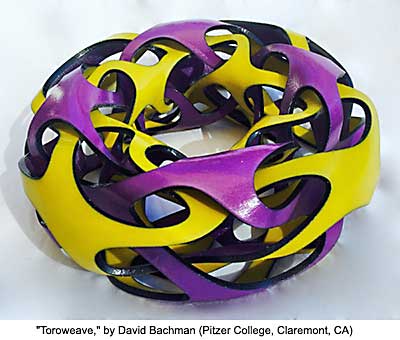
10 x 25 x 25 cm, 3D printed "sandstone" (gypsum powder + binder), 2016. These pieces were each created from two copies of a diamond tiling of a torus. The interior of each face of the tilings was removed, and the resulting webs were alternately offset in opposite directions to form a weave. Complementary colors are used to distinguish the two interlinked forms, which are completely disjoint. -- David Bachman

35 x 45 cm, inkjet print on canvas, 2016. A central curve (not shown) has tangent, normal, and binormal directions at each point, making a local TNB frame. Using a trigonometric combination of the N and B vectors, we describe a toroidal mesh of curves with hues of green, yellow, and orange. Spheres of varying colors and sizes are placed along an equatorial helix and some try to escape their bonds. More information. --- Dan Bach

45 x 45 cm, silk crepe de chine (custom printed via Spoonflower.com), 2016. This reversible infinity scarf is a specially constructed cloth torus such that its shape is invariant under inversion AND it folds flat into a six-layer equilateral triangle. Since the meridians and longitudes of a torus swap places under inversion, one might think the invariance property dictates construction from a square piece of fabric (with opposite edges sewn together). However, although inversion invariance can be achieved with a square construction, the equilateral triangle folding cannot. Can you figure out a possible shape for the flat fabric layout used? The mathematical ideas incorporated into the design of this scarf were developed in collaboration with Charles Wampler. Thanks Carol Maglitta for modeling. More information. --- Ellie Baker

5 x 5 x 5 cm, 3D printed steel, 2016. My work currently revolves around the polyhedral symmetry groups. I pursue this form of art because I am strongly drawn to symmetry and the satisfying sense of beauty and perfection it evokes. My design process is an exploration of the properties of polyhedra. The design for this sculpture is comprised of twelve pi symbols arranged with tetrahedral symmetry. At four different locations, the right legs of three pi symbols spiral into each other, forming vortices in lieu of vertices. --- Sarah Berube
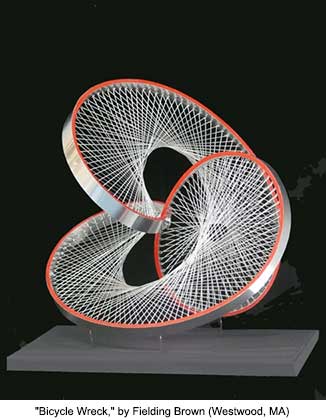
45 x 45 x 45 cm, wood & aluminum frame, silvered mylar strings, 2016. My sculptures are Lissajous figures in 3D. This sculpture is in two parts: an outer frame of laminated hardwood and aluminum, and an inner web of strings. The frame is defined by three, simultaneous, parametric equations, time as parameter. The strings are silvered, package-wrap string, space-defined by a commercial graphing calculator program. The web of strings guides the eye to see imaginary lines and surfaces. --- Fielding Brown

50 x 50 cm, digital print, 2016. This artwork evolved from a search for beauty and patterns within Penrose's non-periodic tiling of the plane with kites and darts. Half darts and half kites can be repeatedly subdivided into five smaller components. Start by labeling these five subcomponents A-E. Then, similar to creating the Sierpinski triangle, alternately subdivide and remove all the components with a certain label. After removing tile type A for three iterations we change to removing tile type B for five more iterations. Instead of painting the tiles remaining, pursuant curves are constructed on the regions removed. --- Douglas Burkholder

48 x 32 cm, digital print, 2016. I began my studies as an art major, but switched to mathematics. When I went to my first conference on fractals I was hooked. Visualizing mathematical concepts allowed me to combine both of my interests. The streamlines of the vector field $\frac{dx}{dt} = x^2 - y^2, \frac{dy}{dt} = 2xy \;$ (the real and imaginary parts of the complex function $f(z) = z^2$ ) are the directed paths along which the tangent vector is equal to $(\frac{dx}{dt},\frac{dy}{dt})$. They are circles tangent to the real axis. the attached vectors are colored according to their slope. --- Anne Burns

60 x 60 cm, archival digital print, 2016. My work is motivated by a fascination with the occurrence of mathematical and scientific imagery in traditional art forms, and the mystical, spiritual, or cosmological significance that is often attached to such imagery. The Klein Quartic is a genus-three Riemann surface which can be covered by a regular tessellation of 24 heptagons. In this image, the Klein quartic is projected into the Poincaré disk, and this heptagonal tessellation is given a regular 8-coloring. Each triplet of heptagons of any given color is fixed by a subgroup of order 21 of the full automorphism group of the surface. --- Conan Chadbourne
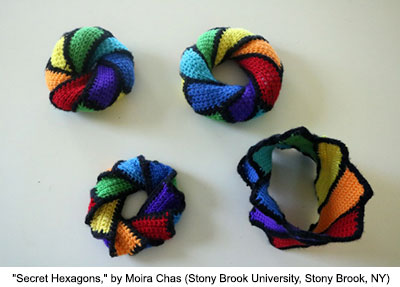
5 x 35 x 35 cm, crochet. This piece addresses the question: What is the maximum number of regions a surface can be divided into, so that each pair of regions share a length of their border (vertices don't count)? In the torus, the maximum number is seven. --- Moira Chas

23 x 23 x 20 cm, galvanized steel wire, 2015. My first experiments with mathematically-themed wire sculpture have been Klein bottles. The concept of producing a sculptural Klein bottle fascinates me, as the two concepts seem to be at odds: a sculpture is, by its nature, 3-dimensional, yet a Klein bottle is not; a sculpture, by its nature, has volume, yet a Klein bottle does not. The "classic" Klein bottle is considerably more "bottle-shaped" than my piece; I decided to shape my piece into a form more resembling two semi-toroids. --- Jennifer Doyle

Best photograph, painting, or print - 2017 Mathematical Art Exhibition
30 x 40 cm, color printer, 2016. This is a fractal pattern whose motifs are monarch butterflies. We modify our usual rule that motifs cannot overlap by allowing the antennas--but not the rest of the motif--to overlap another motif. Expanding on the area rule of the Goals statement, the area of the $n$-th motif is given by $A/(\zeta(c,N)(N+n)^c)$, where $A$ is the area of the region, and $\zeta(c,N)$ is the Hurwitz zeta function, a generalization of the Riemann zeta function (for which $N = 1$; our algorithm starts with $n = 0$). For this pattern $c = 1.26, N = 1.5$, and 150 butterflies fill 72% of the bounding rectangle. --- Doug Dunham
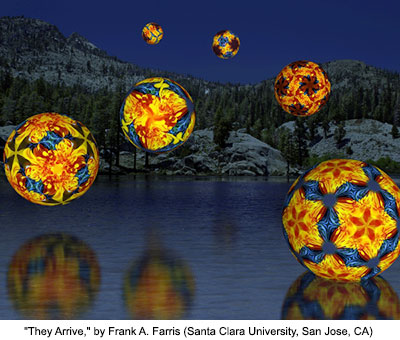
20 x 25 cm, digital aluminum print on DuraPlaq mount, 2016. Glowing globes with three types of polyhedral symmetry drift over a moonlit mountain to land on the lake. Are they wafting from the Platonic world into ours? (The patterns on the globe were created with domain colorings of meromorphic functions invariant under the actions of the three chiral polyhedral groups. In the past, I always used rectangular photographs to paint spheres, resulting in images with singularities. New techniques allow the source photograph to live on the Riemann sphere, allowing poles to be painted just as if they were zeroes. Ray tracing and manipulation of the original daytime mountain photograph were done in Photoshop.) --- Frank A. Farris

20 x 20 x 20 cm, ceramics, 2016. I'm endlessly fascinated by certain aspects of our world, including symmetry, chaos, and infinity. Mathematics allows me to explore these topics in distinctive artworks that I feel are an intriguing blend of complexity and beauty. This abstract sculpture, which mixes biological and geometric forms, is based on a regular hexahedron (more commonly known as a cube). It retains most, but not all, of the symmetries of the cube. --- Robert Fathauer
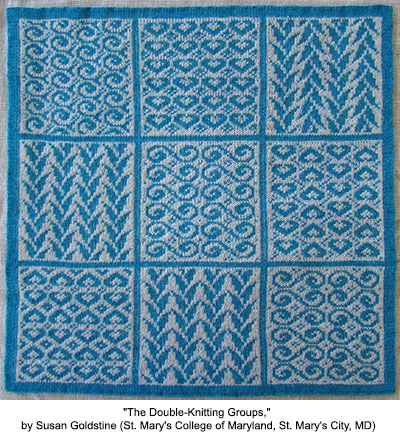
40 x 40 cm, silk/merino yarn, 2016. The Double-Knitting Groups exhibits all of the wallpaper symmetry types possible in double knitting. For a harmonious overall design, I grouped the nine structures into three pattern families: scrolls, hearts, and vines. Roughly speaking, the symmetry groups get more complex from top left to bottom right: the upper left pattern has only translations, the three adjacent to it have only translations and one other type of plane symmetry (clockwise: reflections, rotations, and glide reflections), and the remaining patterns have at least three symmetry types. --- Susan Goldstine

32 x 32 x 32 cm, laser-cut wood, stained, 2016. Thirty components suggestive of "sea monsters" dance around each other, only touching at the hands and mouths. The arrangement of the thirty identical planar parts comes from the face planes of a rhombic triacontahedron, which provides a mathematical foundation for the structure. There are six parts in each of five colors, arranged with a five-color pattern based on the compound of five cubes. The order of the five colors of heads is different around each five-sided opening---all the even permutations. This was a prototype model for a larger (4-foot diameter) version of this design, installed at the Burr and Burton Academy in Vermont. The name "Champy" comes from the legend of a reputed lake monster said to be living in Lake Champlain. --- George Hart
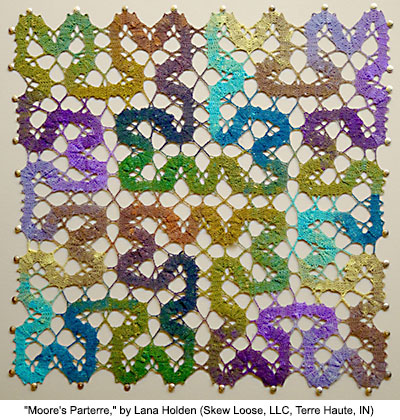
60 x 60 cm, cotton, wool, polyamide, and silk yarn, 2014. The essence of Bruges crochet technique is the making of a crocheted tape that is shaped as it is made into a curve to form dense lace. I became interested in exploring it for creating space-filling curves. I experimented with the classic Hilbert curve for early studies, but chose Moore's variation for the larger work for a couple of reasons. First, the inherent symmetries of Moore curves are aesthetically pleasing. More importantly, in Moore curves, the starting point and endpoint are adjacent points, allowing the piece to be a closed loop. (Can you find the join?) The long color sections of the yarn used display the point clustering properties of Hilbert/Moore curves. --- Lana Holden
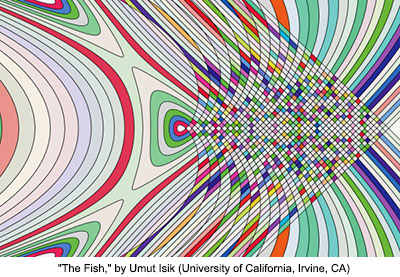
28 x 43 cm, print, 2016. I have built a software infrastructure for producing artworks from simple mathematical functions. This creates a new medium for artistic and mathematical expression; one where it more natural to work with simple mathematical descriptions rather than imperative/iterative processes. In this work these algebraic curves divide the plane into many regions. I colored these regions using a probability distribution that produces a mixture of strong and light colors. --- Umut Isik
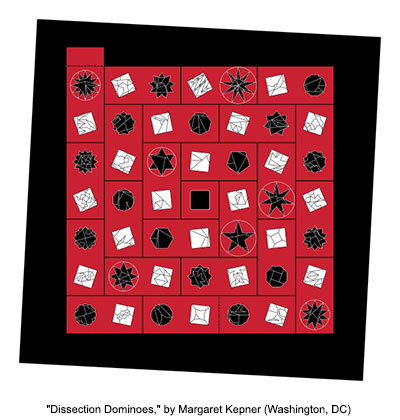
50 x 50 cm, archival inkjet print, 2016. This piece contains 24 'dominoes' and one square, arranged in a spiral pattern. Each domino has two shapes: a white square and a black polygram (or star). These shapes are cut into subparts so as to be geometric dissections of each other. For example, the upper-right domino displays a dissection of a square into seven pieces that can be reassembled into the adjacent decagon. The domino directly below also displays a dissection of a square into a polygram with 10 vertices, but with every second one connected ($\{10/2\}$). Continuing down the right-hand side, there are dominoes showing dissections of the $\{10/3\}$ and $\{10/4\}$ shapes. This work provides opportunities for studying the properties--and enjoying the beauty--of geometric dissections. --- Margaret Kepner

Honorable Mention - 2017 Mathematical Art Exhibition
66 x 46 x 3 cm, hand dyed silk ribbon, 2016. This permutated pair of triaxial weavings are exactly identical in weave structure, with identical color sequencing in all three directions. (AAABBB) Only the starting points of the color sequence in the diagonal elements vary between the two. --- Mary Klotz
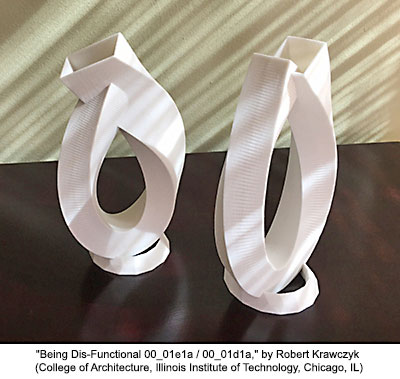
19 x 8 x 12 cm, sandstone, 2016. Lemniscate of Bernoulli, included angle of 90 and 290 degrees with a 225 degree twist; 90 and 270 degrees with a 180 degree twist. This series investigates a simple form based on approximately one-half of a Lemniscate of Bernoulli curve, developed about 1694. It is very similar to a common eight curve, except the loops are more elliptical. For the enclosure a simple solid surface was incorporated. Custom software has been developed to generate these containers. These containers are computationally generated by custom developed software, a method which can express a consistency of a developing concept and enable a variety of designs that focus on the idea and its variations. Then the digital model is 3D printed in sandstone. More information.--- Robert Krawczyk

25 x 25 cm, digital print, 2016. The algorithm used to create this image is the same as that used to recursively define the Koch curve. In this case, the circle is divided into 336 parts (rather than 360 degrees), and the angles used in the algorithm are 283 and 179 of these parts (rather than 60 and 240 degrees). In this case, the curve is bounded, consists of 10,752 segments, and possesses 42-fold symmetry. --- Vincent J. Matsko
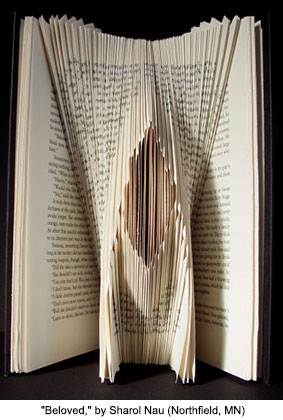
25 x 17 x 18 cm, folded book, 2016. I enjoy folding the pages of a book systematically, especially based on a parabola because of an important option of placing the focus anywhere which leads to surprising shapes, arch curves that spring forward as the book opens. 'Beloved' was created by matching incremental points on an edge of the pages to a common point, the focus of a parabola. The collection of folds makes an envelope to the parabola. In this case I decorated a bit by including a focus near the top complementary to one at the bottom of the page. --- Sharol Nau
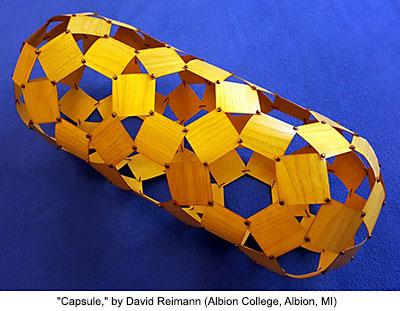
18 x 45 x 18 cm, paper backed cherry veneer, metal fasteners, 2016. This is a capped cylinder was created using 75 squares that are 5 cm on a side and connected at their corners using split-pin fasteners. The end-caps are based on dodecahedral hemispheres and the cylinder is based on a planar hexagonal tessellation, which results in a polyhedral form in which every vertex has order 3. The edges in the underlying form have been replaced by squares, resulting in an open lattice form. Every opening is either triangular (throughout), pentagonal (on the endcaps), or hexagonal (on the cylinder). --- David Reimann
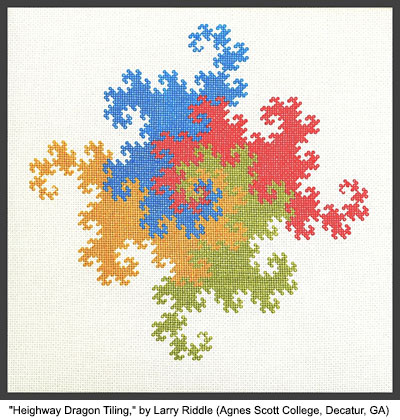
25 x 25 cm, back stitch embroidery on 18 count canvas, 2012. The Heighway Dragon fractal was introduced to mathematicians by Martin Gardner in his Mathematical Games column of Scientific American. One of the amazing properties of the dragon is that despite its boundary being extremely non-smooth, four copies of the dragon fit exactly together around a central point. This back stitch design illustrates that mathematical idea by showing 4 copies of 12 iterations in the construction of the dragon via line segments, each rotated in succession by 90º around the center. The entire image can then be repeated to tile the plane. What might not be obvious from the design is that each dragon can be traced starting at the center point as one continuous alternating sequence of vertical and horizontal stitches. More information. --- Larry Riddle

47 x 47 x 8 cm, Venetian glass on wood hand cut by artist, 2016. This mosaic wall sculpture consists of tessellated (tightly fitted together) patterns and each sculpture is a 3D disc with 18.5" diameter. The hyperbolic sculpture is composed of planes, each suggests negative curvature and represents the concept of infinite smallness contained within the bounding edge. Hyperbolic geometry can be represented as the points in a circular disc with hyperbolic distance defined. A hyperbolic plane has infinite structures within boundaries.In my hyperbolic sculpture repeating patterns which decrease in size at the bounding edge metaphorically represent infinity. Symmetry is a transformation that preserves the distance as shown on the surface tiling patterns of the sculpture. --- Irene Rousseau
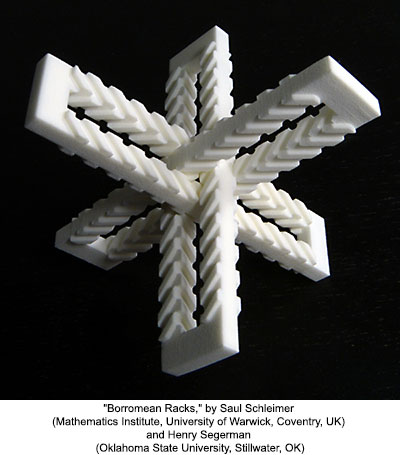
10 x 10 x 10 cm, 3D printed nylon plastic, 2013. This sculpture consists of three identical pieces. Each has two identical rods; each rod is a rectangular prism with racks on three of its four sides. These racks mesh with one or two racks on the other pieces, for a total of 12 meshings. The pieces interlink in the fashion of the Borromean rings; their long axes form a standard orthogonal frame. When we take the directions of the racks into account, the sculpture has a handedness. At its middle position it realizes its maximal symmetry, a dihedral group of order six. Curiously, the Borromean Racks give an example of a triple of gears that mesh pairwise, but are not frozen. Challenge: Does this pattern of racks extend to tile three-space? If so, how many degrees of freedom does it have? --- Saul Schleimer and Henry Segerman

48 x 40 x 30 cm, pvc-pipes, painted, 2016. With Walt van Ballegooijen we have studied the number of topologically different ways in which two identical tetrahedral wire-frames could be interlinked. Not counting mirror images separately, we have found eleven different configurations. For each topological configuration there is a maximal clearance between the infinitely thin mathematical wire frames. If the edges are expanded to a diameter identical to this clearance, then a rigid structure results. This particular configuration has been scaled up to accommodate fattened edges of 22mm diameter, the size of the PVC pipes employed. --- Carlo Séquin
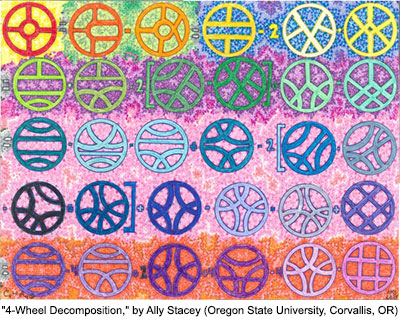
45 x 60 cm, Crayola crayon and Sharpie, 2015. Learning math inspires me to make art which in turn helps me better understand the math. This work is essentially a change-of-basis calculation going from the space of Closed Jacobi diagrams (trivalent graphs with an outer circle) to the space of Chord Diagrams, which are trivalent graphs with all vertices on the outer circle. These algebras are important to the field of Vassiliev Knot Invariants. This is done via what's the called the STU relation which is a way of resolving internal vertices. All algebraic steps are shown in the foreground. Making these helps me keep track of calculations in my research in an aesthetically pleasing way. --- Ally Stacey

50 x 50 x 5 cm, digital print on canvas, 2016. "Animal Heads - Wolf" is made from hundreds of tessellating wolves. It uses a mosaic technique that I developed specifically to create mathematical artwork. As with traditional square mosaics, each tile is a different colour. In this case, the individual tiles are howling wolves. Look closely to see the detail on each, or take a step backwards and the wolf head is revealed. --- Chris Watson

Best textile, sculpture, or other medium - 2017 Mathematical Art Exhibition
45 x 45 x 20 cm, Hi-tec Kozo paper, 2014. "Torus" is folded from one single sheet of uncut paper. Gauss's Theorema Egregium states that the Gaussian curvature of a surface doesn't change if one bends the surface without stretching it. Therefore, the isometric embedding from a flat square or rectangle to a torus is impossible. The famous Hévéa Torus is the first computerized visualization of Nash Problem: isometric embedding of a flat square to a torus of C1 continuity without cutting and stretching. Interestingly, the solution presented in Hevea Torus uses fractal hierarchy of corrugations that are similar to pleats in fabric and folds in origami. In my Torus, isometric embedding of a flat rectangle to a torus of C0 continuity is obtained by using periodic waterbomb tessellation. --- Jiangmei Wu


